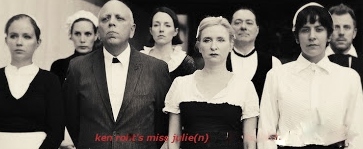GAY ABSTRACTION
For years, Ken Roht has proved himself to be one of the most inventive theater practitioners in Los Angeles. His avant-garde works include the renowned 99 Cent Only shows, which contain extravagant costumes by Ann Closs-Farley and sets wholly manufactured with items acquired at the 99 Cent Only Store. The original, entertaining and fantastical song-and-dance spectaculars proved that it is imagination, not money, which is the root of authentic art.
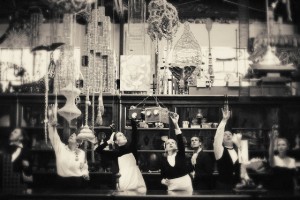 Now the multi-faceted Roht puts his surreal touch on Strindberg’s Miss Julie (1888), groundbreaking for its naturalism, frank sexuality and psychological character study. The play is a battle of wills between Julie, a misfit of the aristocracy to which she belongs, and Jean, a well-mannered and worldly footman to her father, a Count. There is a minor character who bookends this “naturalistic tragedy” (Strindberg’s subtitle), Kristin – a cook full of morality and religion who is also Jean’s fiancée – but it is essentially a two-person play: A tug-of-war for power as a valet and a Count’s unmarried daughter (a Komtesse) vacillate between servitude and control, both seeking liberation from authority even as they dominate one another.
Now the multi-faceted Roht puts his surreal touch on Strindberg’s Miss Julie (1888), groundbreaking for its naturalism, frank sexuality and psychological character study. The play is a battle of wills between Julie, a misfit of the aristocracy to which she belongs, and Jean, a well-mannered and worldly footman to her father, a Count. There is a minor character who bookends this “naturalistic tragedy” (Strindberg’s subtitle), Kristin – a cook full of morality and religion who is also Jean’s fiancée – but it is essentially a two-person play: A tug-of-war for power as a valet and a Count’s unmarried daughter (a Komtesse) vacillate between servitude and control, both seeking liberation from authority even as they dominate one another.
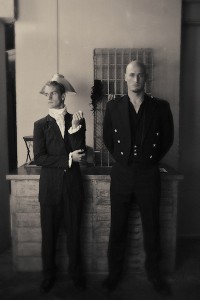 Aside from Roht’s stunning visual setting in the MorYork Gallery, the simple yet jaw-droppingly effective device which will forever separate his adaptation (with Erik Patterson) from the myriad of Miss Julie productions staged worldwide arrives courtesy of one letter – “n.” The spoiled, bratty, titular 25 year-old malcontent is now Julien, a revelational alteration which thrusts Strindberg’s Darwinian take on social processes and personal relationships into the modern age, even as Roht retains a patina of turn-of-the-century Sweden. The battle between the sexes is now transformed into a battle of wills between an upper class, alienated, effeminate gay man (Julien) and a calculating, unscrupulous straight man (John). The scene of lustful consummation as the two hide from intruding revelers illuminates both a gay man’s desperation caused by repression and the hypocritical puritan supremacy of a heteroarchy. “This was supposed to be a night of meaningless fun,” Julien jokingly laments after the liaison, but we can see his realization that the same self-loathing and exclusion which led to this act may always remain. That is why this adaptation sheds light on the degeneration of a gay man’s spirit which can ultimately lead to suicide.
Aside from Roht’s stunning visual setting in the MorYork Gallery, the simple yet jaw-droppingly effective device which will forever separate his adaptation (with Erik Patterson) from the myriad of Miss Julie productions staged worldwide arrives courtesy of one letter – “n.” The spoiled, bratty, titular 25 year-old malcontent is now Julien, a revelational alteration which thrusts Strindberg’s Darwinian take on social processes and personal relationships into the modern age, even as Roht retains a patina of turn-of-the-century Sweden. The battle between the sexes is now transformed into a battle of wills between an upper class, alienated, effeminate gay man (Julien) and a calculating, unscrupulous straight man (John). The scene of lustful consummation as the two hide from intruding revelers illuminates both a gay man’s desperation caused by repression and the hypocritical puritan supremacy of a heteroarchy. “This was supposed to be a night of meaningless fun,” Julien jokingly laments after the liaison, but we can see his realization that the same self-loathing and exclusion which led to this act may always remain. That is why this adaptation sheds light on the degeneration of a gay man’s spirit which can ultimately lead to suicide.
While most productions of Miss Julie use only three actors, Strindberg actually calls for peasants who offer music and dance, which Roht uses to full advantage. The real-time narrative takes place during the servants’ midsummer party. At the top, the eight-member chorus sings a bittersweet, rich, slow madrigal composed by Stephen Heath, which lingers even as Christine (a practical and stiff-natured Erica Rice) 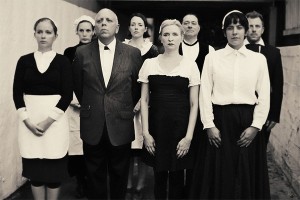 prepares a meal. As the scene progresses, the servants mechanically clean in slow-motion around the perimeter, showcasing Roht’s broad, balletic and entirely effective choreography.
prepares a meal. As the scene progresses, the servants mechanically clean in slow-motion around the perimeter, showcasing Roht’s broad, balletic and entirely effective choreography.
Also on the scene is Malik, a replacement for Miss Julie’s impregnated dog, Clara. Donning a skeleton leotard costume, the pliable and buoyant Oscar Pereira is an enigmatic figure who is part dog and, as with the servants, part Greek Chorus. The leotard and the other costumes – part music hall, part commedia and part medieval peasant wear – are the inventive concoctions of Ms. Rice.
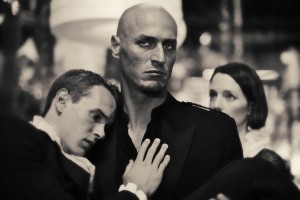 The gallery’s eclectic display of art and glass cases is utilized to create the scullery of a dilapidated mansion. Allow yourself to peruse the whimsical artwork (created and curated by Clare Graham) up close prior to curtain. As the actors already in character mill about the space with you, notice the tree-like sculptures constructed of motel room keys, buttons, puzzle pieces, pull tabs and more. Once you view the scene seated on steel bleachers, the setting – a Seurat-like pointillist wonder of vibrant but muted colors (gold, rust, yellow, chestnut) – will make you feel as if you were in a stunningly beautiful 3-D painting, aided in no small part by Kirk Wilson’s directional lighting, which uses fixtures one would find in an artsy Silverlake home. Had Vermeer dabbled in impressionism, this visual feast may have been the result.
The gallery’s eclectic display of art and glass cases is utilized to create the scullery of a dilapidated mansion. Allow yourself to peruse the whimsical artwork (created and curated by Clare Graham) up close prior to curtain. As the actors already in character mill about the space with you, notice the tree-like sculptures constructed of motel room keys, buttons, puzzle pieces, pull tabs and more. Once you view the scene seated on steel bleachers, the setting – a Seurat-like pointillist wonder of vibrant but muted colors (gold, rust, yellow, chestnut) – will make you feel as if you were in a stunningly beautiful 3-D painting, aided in no small part by Kirk Wilson’s directional lighting, which uses fixtures one would find in an artsy Silverlake home. Had Vermeer dabbled in impressionism, this visual feast may have been the result.
Missing from the production is emotional realism between John (Dylan Kenin) and Julien (Jonny Rodgers). Rodgers’ waiflike take is fittingly B movie melodrama – childlike and temperamental – whereas Kenin’s calm, austere fortitude is still and internalized to the point of threatening. Both are appropriate interpretations, but 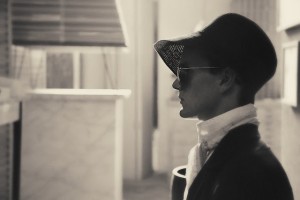 without emotional charge between the two, long exchanges of dialogue become ponderous, made all the more laborious by the implacable seating with no back support.
without emotional charge between the two, long exchanges of dialogue become ponderous, made all the more laborious by the implacable seating with no back support.
Still, this production is everything that the Wooster Group’s masturbatory, alienating Early Plays at REDCAT was not: Accessible entertainment that has something to say while remaining true to the abstract art of the avant-garde. It’s criminal that there are only 12 performances. This is one Julien you don’t want to miss.
photos by Ashley West Leonard
Ken Roht’s Miss Julie(n)
Orphean Circus (with Firehouse Theater Company and MorYork Gallery)
at MorYork Gallery, 4959 York Blvd, in Highland Park
scheduled to end on March 10, 2013
for tickets, call 323.515.2482 or visit http://www.missjulien.com
